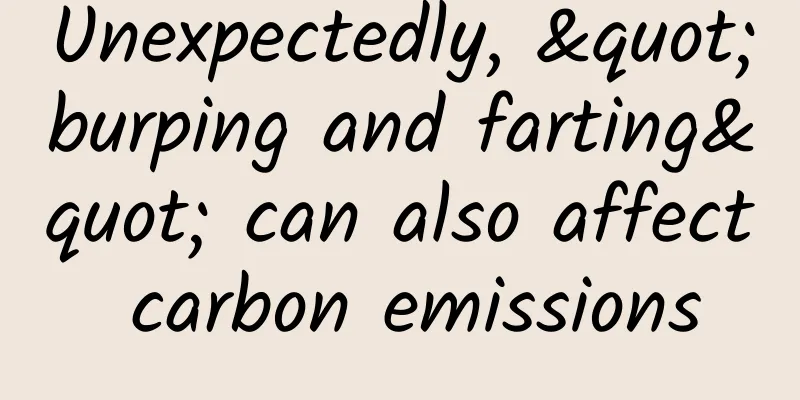Unexpectedly, "burping and farting" can also affect carbon emissions

|
What are bull farts and why should we collect them? Cows are herbivores. In order to decompose the cellulose, lignin and other nutrients in plants and high-fiber feeds, cows use the rumen, reticulum, omasum and abomasum to fully digest food. Rumination is when the cow takes the food that has been eaten and reaches the stomach and returns it to the mouth for a second chewing, so that the undigested plants return to the stomach again, promoting the full decomposition of food. It is still difficult for cows to fully absorb the nutrients in plants through mechanical chewing. Here we need to mention everyone’s good friend - microorganisms. There are more than 400 kinds of microorganisms in the cow’s stomach, most of which parasitize in the rumen, the cow’s largest stomach. After the food is decomposed by microorganisms, it will be regurgitated and then go to the cow's mouth. After being chewed again by the cow, it will go to the reticulum, omasum, and finally to the abomasum. The abomasum has similar functions to the human stomach and can secrete gastric acid, but the acidity of gastric acid is not strong and can only kill a few acid-intolerant microorganisms. After that, the food will be excreted from the body through the digestive system. Among the four stomach chambers, the rumen can be regarded as a feed processing plant, where 70 to 85% of the digestible matter and 50% of the crude fiber in the feed are digested. Under the action of various microorganisms such as bacteria, methanogens, fungi and protozoa, the feed in the rumen is fully decomposed and fermented to produce gases, the main components of which are: carbon dioxide, methane, hydrogen and nitrogen. These gases cannot be used by animals and are discharged from the body in the form of burps and farts. Methane and carbon dioxide are both important greenhouse gases that will cause global warming. Smart readers, have you figured out the question at the beginning of this article? The "cow fart collection bag" is a device "tailor-made" to prevent the methane and carbon dioxide gases from cows' burps and farts from being released into the air. The breeder will install a red plastic box on the back of the cow, connect it to a tube inserted into the cow's stomach, and collect the gas emitted by the cow's burps and farts. This "cow fart bag" can collect up to 300 liters of methane, and researchers can convert this methane into "natural gas" for automobile fuel, which can be used for a car for up to 24 hours. However, this device is still in the research stage and has not been put into use on a large scale. Seeing this, some friends may have a new question. There are many ruminants. Do they all emit greenhouse gases? Yes, according to research, the farts of ruminants such as cows, sheep, and deer also contain greenhouse gases, but they are relatively less. Cow burps are more worthy of attention! In fact, when it comes to greenhouse gases, everyone's first reaction is carbon dioxide. In terms of emissions, carbon dioxide is indeed the most common greenhouse gas. Although the total amount of methane is far less than the total amount of carbon dioxide in the atmosphere, the greenhouse effect potential of each molecule of methane is 25 times that of carbon dioxide. The so-called greenhouse effect potential is actually an index, which generally refers to the greenhouse effect that various greenhouse gases can cause within 100 years, based on carbon dioxide as a benchmark. This mainly depends on the chemical's ability to absorb infrared rays and its lifespan in the atmosphere. Methane not only has a strong ability to absorb infrared rays, but also has a long lifespan in the atmosphere, and can generally stay in the air for 9-15 years. In fact, 90% to 95% of the methane released by cows comes from their mouths, while the other 5% to 10% is released in the form of feces and farts. In other words, in terms of causing the greenhouse effect, cow burps are much more powerful than cow farts. Which one is stronger in greenhouse gases? Compared to methane emitted by fossil fuels, methane from animal husbandry itself is part of the Earth's carbon cycle. After the grass eaten by cattle is fermented in the rumen, it can be decomposed into water and carbon dioxide in about 10-20 years, and then reabsorbed by plants through photosynthesis, completing the carbon cycle. This process does not produce additional carbon emissions. Methane from the fuel industry releases stored carbon, so it is more urgent to address methane emissions from the fuel industry than from animal husbandry. Therefore, although we don’t have to be afraid of cows, taking effective measures to reduce methane emissions from ruminants cannot be ignored. This is how we reduce carbon emissions! Studies have found that there are three main ways to reduce methane production in ruminants: first, reducing the number of methanogens; second, competing for H2 and converting H2 into other substances; and third, reducing the activity of enzymes in the methane production process. These three channels can be regulated nutritionally. In terms of nutritional regulation of methane production, the amount of methane produced can be reduced by changing the type of diet, adjusting the ratio of refined to roughage in the diet or the balance of energy and protein, controlling the amount of animal feed intake, adding various feed additives to the feed, or adjusting the rumen pH by adding chemicals, etc., reducing the metabolic and conversion pathways. In 2020, General Secretary Xi Jinping stated at the general debate of the 75th United Nations General Assembly that my country will strive to peak its carbon dioxide emissions before 2030 and strive to achieve carbon neutrality before 2060. To achieve this goal, my country has participated in the international carbon trading market since 2005. As of December 31, 2020, including Fujian Province, which joined later, the eight pilot carbon market quotas had a cumulative spot transaction of 445 million tons, a transaction volume of 10.431 billion yuan, and a transaction price of 23.5 yuan per ton. In addition, the national certified emission reductions (CCERs) had a cumulative transaction of 268 million tons. In addition, my country will continue to vigorously promote the optimization and adjustment of industrial structure, accelerate the construction of a clean, low-carbon, safe and efficient energy system, consolidate and enhance the carbon sequestration capacity of ecosystems, and comprehensively accelerate the comprehensive green transformation of the economy and society. Carbon emission reduction is something that each of us can do. Without lowering the living standard, there is still a huge space for saving energy in residents' lives. Energy conservation in housing, transportation, and household appliances are all aspects of our daily lives. In what ways do you practice energy conservation and emission reduction in your life? Welcome to leave a message in the comment area to discuss! Creative team: China Science and Technology Museum New Media Team Review expert: Ji Shi, an observer in the field of life and a well-known popular science writer on biology The cover of this article is from the copyright gallery and is not authorized for reproduction |
>>: 2021 China report card is here
Recommend
Collect! Enjoy the flowers and eat the fruits at the same time, these fruit trees can also be planted on the balcony →
Auditing expert: Yang Yanhui, Senior Garden Engin...
Ancient fruit preservation: How dare you let the queen eat rotten melons?
Produced by: Science Popularization China Author:...
Five major trends in intelligent connected cars: cars will become computers on wheels
Technology is reshaping the future of the global ...
The clearest and most comprehensive method for writing operation and promotion plans!
Operations are basically a process of constantly ...
Doctors warn: This change in nails may be cancer! Don't take it lightly
When you cut your nails, have you ever noticed th...
Crab Boss's Super Strategy for Douyin Live Streaming Sales: Detailed gameplay of Douyin live streaming sales, small store operation, paid delivery, etc.
Tik Tok live streaming advanced course, start fro...
If you have these 5 daily necessities at home, it is recommended to throw them away immediately
One minute with the doctor, the postures are cons...
How do I attract targeted customers through Zhihu?
Hello everyone! The following tutorial can help y...
How to acquire seed users without money or resources?
When a new product is just starting to operate, I...
Analysis of member activity promotion techniques!
This article once again focuses on a membership a...
Get the guide to creating hot-selling products in the second category of e-commerce!
Nowadays, "Internet + e-commerce" has p...
One set of models to solve the core selling point planning of the brand
The company's new brand is about to enter the...
How to plan a community event with no experience?
Based on the author's thoughts and ideas from...
H5 marketing hot spots in January 2020
In the blink of an eye, today is already the thir...
Jiucheng and Faraday Future signed a joint venture agreement to invest US$600 million
On the morning of March 25, Internet company The9...









